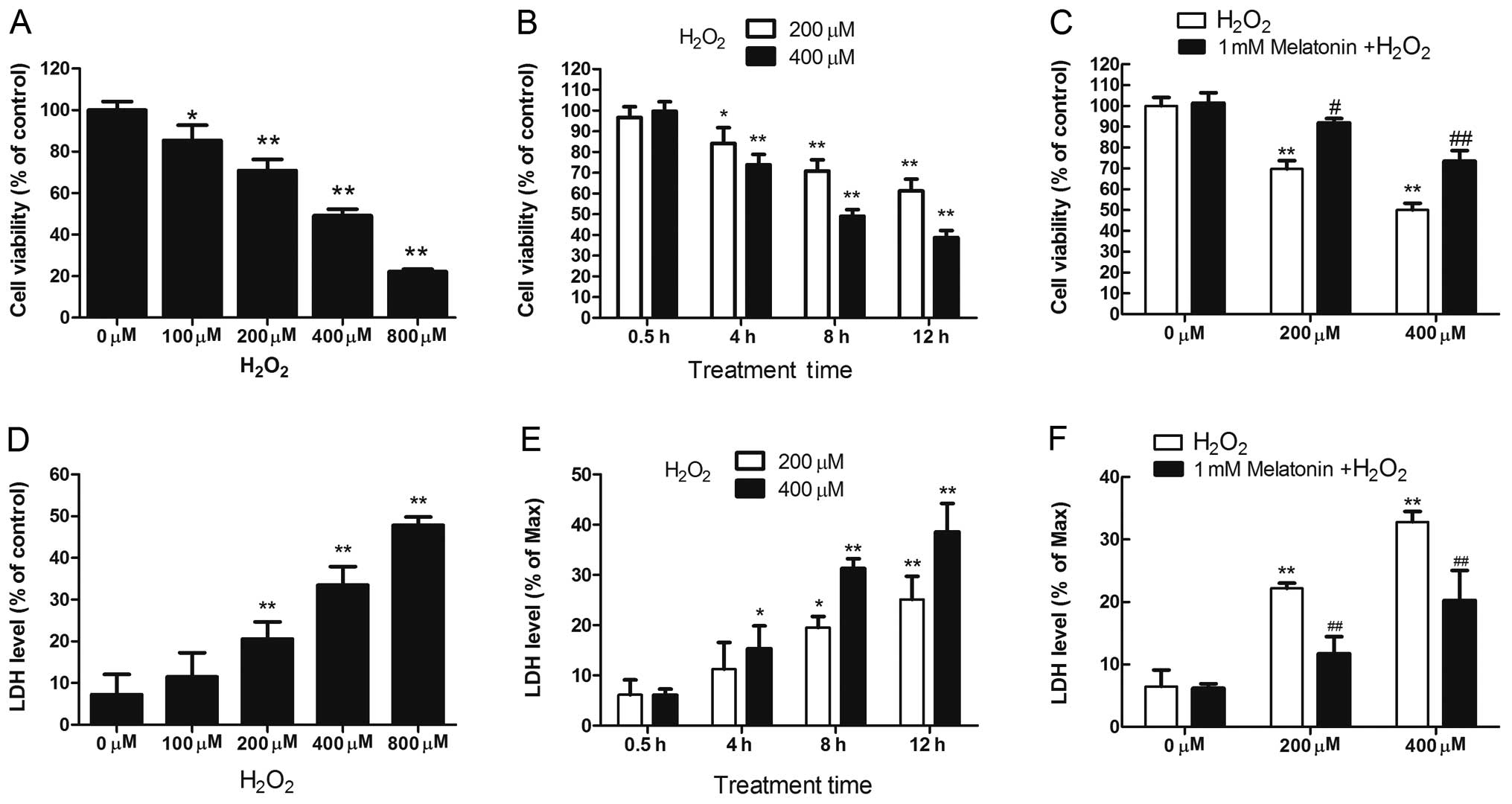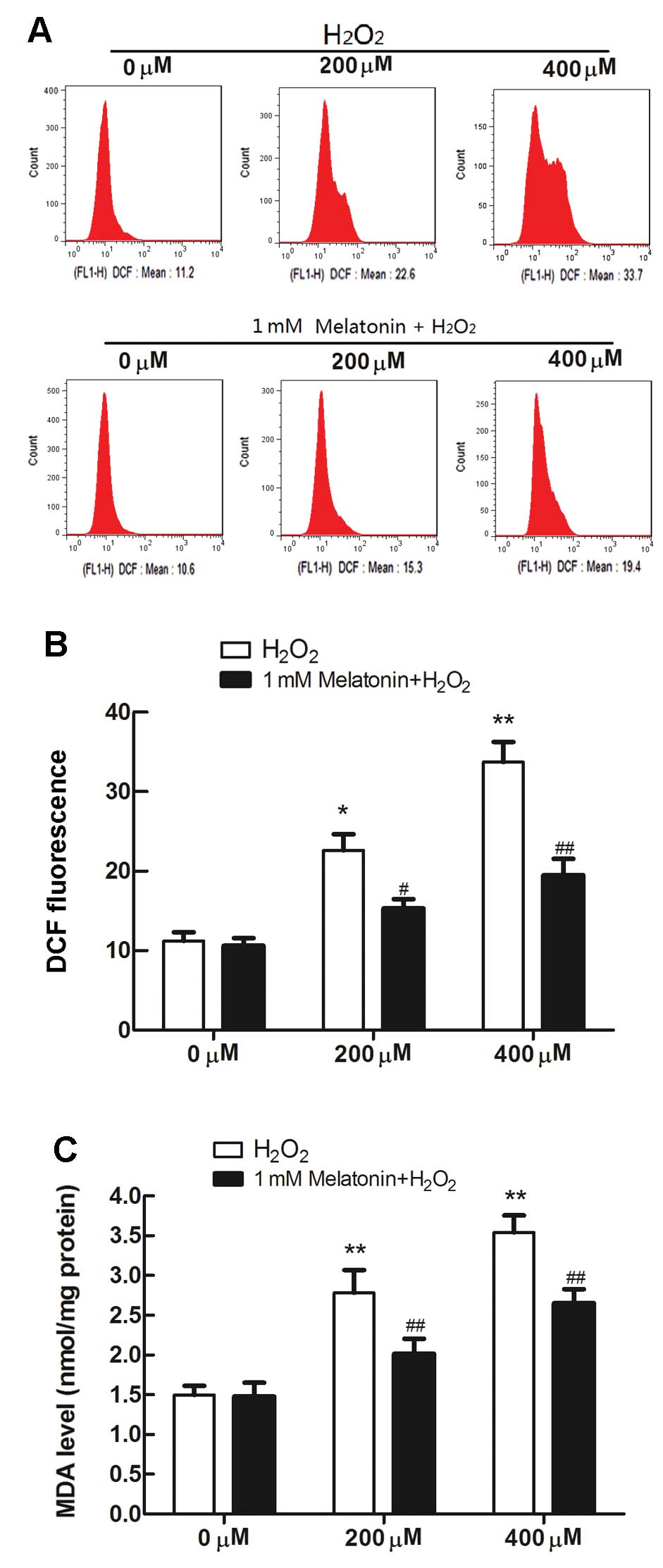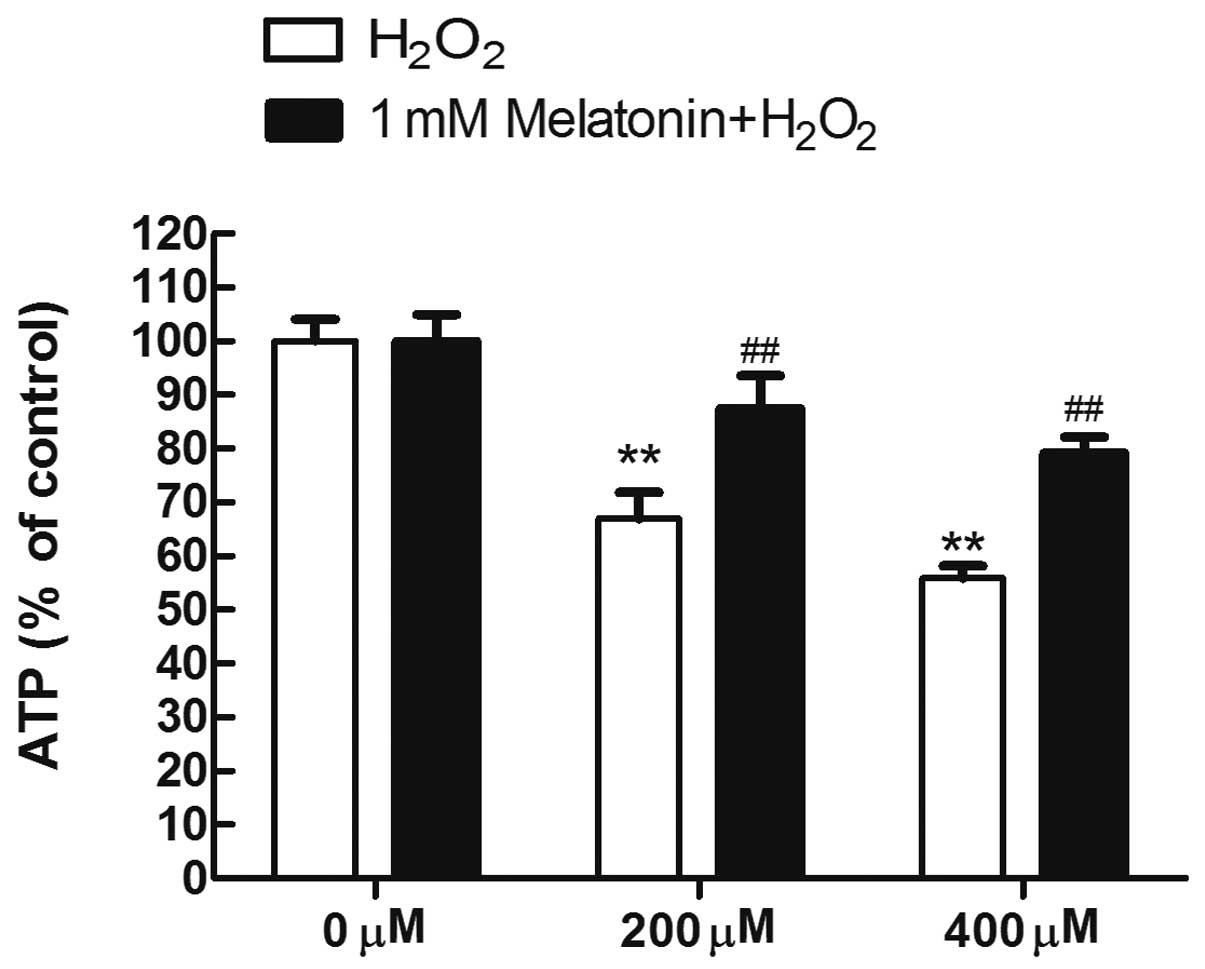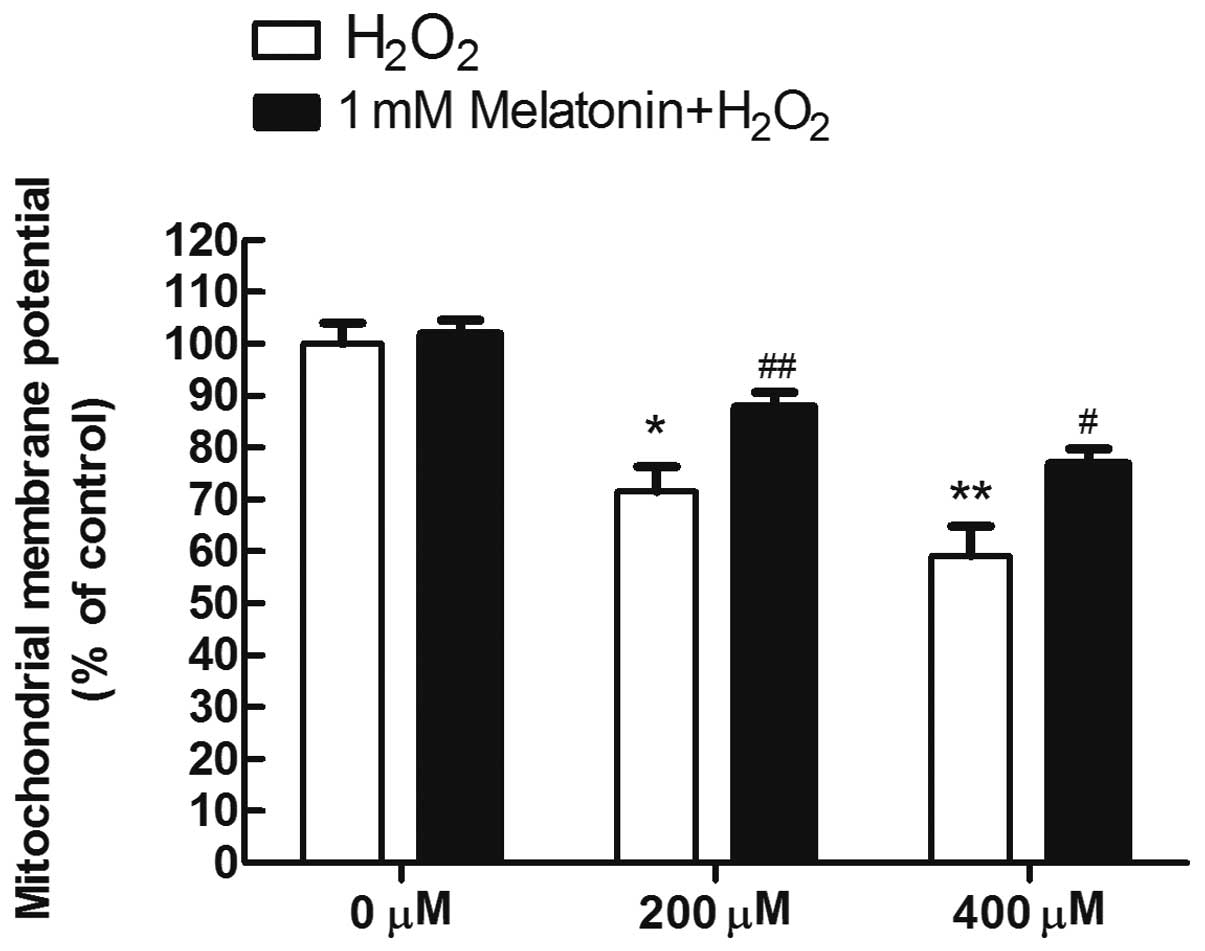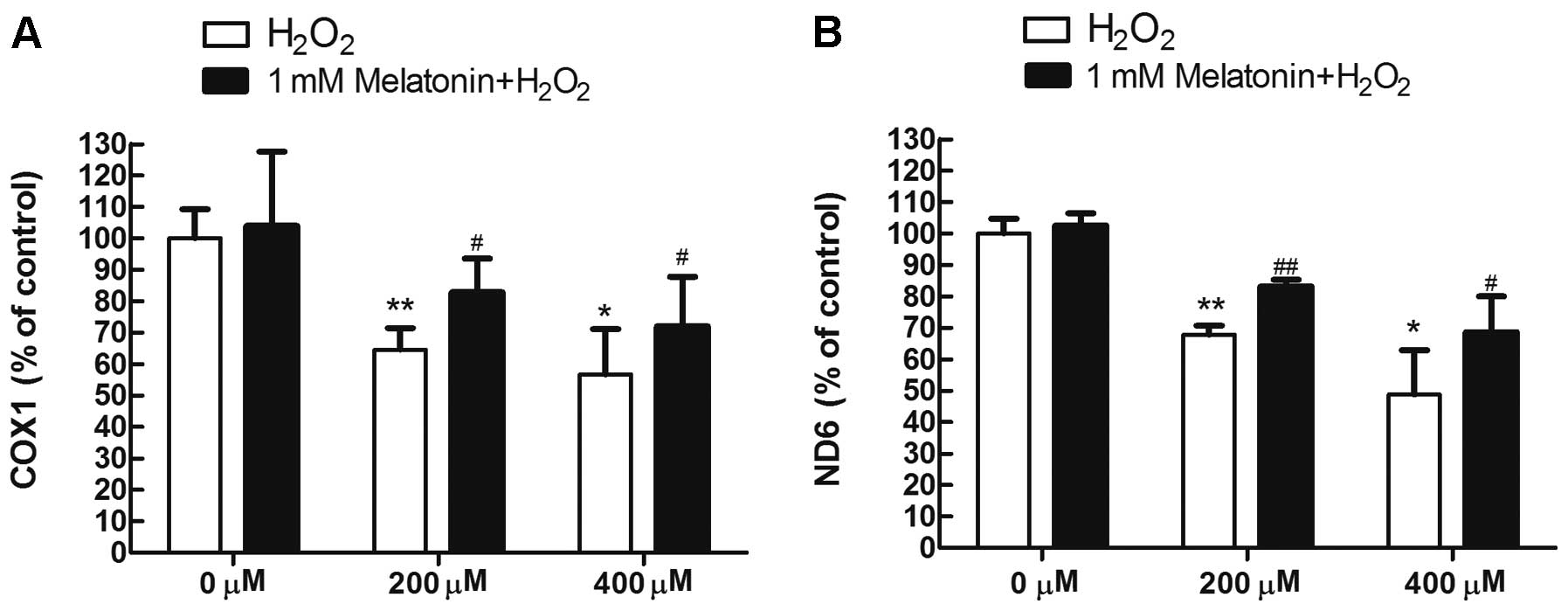Melatonin protects MG63 osteoblast-like cells from hydrogen peroxide-induced cytotoxicity by maintaining mitochondrial function
- Authors:
- Published online on: November 28, 2013 https://doi.org/10.3892/mmr.2013.1832
- Pages: 493-498
Abstract
Introduction
Osteoporosis is a systemic skeletal disease characterized by low bone mineral density and micro-architectural deterioration of bone, leading to increased bone fragility and susceptibility to fractures (1). The clinical complications of osteoporosis include pain, fractures and disability. Recently, osteoporosis has become a predominant public health problem in elderly individuals, particularly in postmenopausal females (2). Reactive oxygen species (ROS) such as superoxide anions, hydroxyl radicals and hydrogen peroxide (H2O2) lead to severe damage to DNA, protein and lipids. Therefore, ROS is a predominant cause of cell damage and death in numerous pathological conditions (3). Furthermore, it has been demonstrated that ROS-induced bone cell cytotoxicity is critical in the development of osteoporosis (4). Under normal physiological and pathological conditions, the mitochondria are the predominant producers of ROS, such as hydrogen peroxide, hydroxyl radicals, superoxide radicals and singlet oxygen (5). Additionally, the mitochondria are the key targets of ROS-mediated damage (6). It has been shown that mitochondrial dysfunction is involved in ROS-induced bone cell cytotoxicity (2,7). Therefore, it is plausible that therapeutic strategies which aim to prevent or delay ROS-induced bone cell cytotoxicity by maintaining mitochondrial function may be suitable for the prevention or treatment of bone loss-related disorders.
Melatonin is an indoleamine primarily secreted by the pineal gland and is also synthesized in other organs, such as the skin (8), gastrointestinal tract (9), thymus (10), retina (11) and bone marrow (12). Melatonin is involved in the regulation of several physiological processes such as sleep-wake rhythms (13,14), regulation of the circadian cycle (15,16), seasonal control of reproductive processes (17) and immune processes (18). In addition to these physiological actions, melatonin is a potent scavenger of ROS, such as the carbonate radical (19), which is presumed to be involved in mitochondrial damage (20). Furthermore, melatonin easily enters the mitochondria and exerts a direct beneficial effect on the maintenance of mitochondrial homeostasis (21). It has also been demonstrated that melatonin stabilizes the mitochondrial inner membrane, improves electron transport chain activity, increases ATP synthesis and protects mitochondrial DNA from oxidative damage (22–25). Based on the mitochondrial dysfunction observed during ROS-induced bone cell cytotoxicity and the beneficial effects of melatonin on the mitochondria, melatonin may be a useful molecule for preventing or treating diseases related to bone loss.
The aim of the present study was to investigate the potential efficacy of melatonin in the protection against ROS-induced bone cell cytotoxicity. To address this issue, the MG63 osteoblastic cell line was exposed to different concentrations of H2O2. As expected, melatonin pretreatment successfully attenuated H2O2-induced cytotoxicity in MG63 cells. The protective effects of melatonin were correlated with its ability to reduce oxidative damage, increase ATP production, maintain the mitochondrial membrane potential and preserve mitochondrial DNA content in H2O2-treated cells. This study suggests that melatonin effectively protects against H2O2-induced cytotoxicity in MG63 osteoblastic cells by maintaining mitochondrial function.
Materials and methods
Chemicals
H2O2 was purchased from Sigma-Aldrich (St. Louis, MO, USA). Melatonin was obtained from Sangon Biotech Co., Ltd. (Shanghai, China). The cell lysis buffer and bicinchoninic acid (BCA) protein assay kit were purchased from Beyotime (Shanghai, China).
Cell culture and treatments
MG63 osteoblast-like cells (American Type Culture Collection, Manassas, VA, USA) were cultured in Dulbecco’s modified Eagle’s medium (DMEM; Hyclone, Logan, UT, USA) supplemented with 10% heat-inactivated fetal bovine serum (FBS; HyClone) and 80 μg/ml penicillin/streptomycin (Sigma-Aldrich) in a 5% CO2-humidified atmosphere at 37°C. To estimate the toxicity of H2O2, MG63 cells were seeded at a density of 1×104 cells/well in 96-well plates, cultured overnight and then exposed to various concentrations of H2O2 (0, 200, 400 or 800 μM) for 8 h, or exposed to 200 or 400 μM H2O2 for different periods of time (0.5, 4, 8 and 12 h). In other assays unless otherwise stated, the cells were seeded at a density of 2×105/well in 6-well plates, cultured overnight, pretreated with melatonin (1 mM) for 2 h and then exposed to H2O2 (200 or 400 μM) for 8 h.
Measurement of cell viability and lactate dehydrogenase (LDH) release
The viability of MG63 cells was assessed using the Cell Counting kit-8 (CCK-8; Dojindo, Kumamoto, Japan) according to the manufacturer’s instructions. Following treatment with H2O2, the cells were cultured in 100 μl fresh growth medium supplemented with 10 μl CCK-8-solution for 2 h at 37°C and the absorption values were measured at 450 nm using a microplate reader. Cell viability was expressed as a percentage of untreated control cells (set at 100%). All the experiments were performed in triplicate and were repeated three times.
LDH release was measured using the Cytotoxicity Detection kit (Roche, Mannheim, Germany) according to the manufacturer’s instructions. The cells were pretreated with melatonin and exposed to H2O2 in a low-serum (1% FBS) medium, in order to minimize the effects of LDH in the serum. Following treatment, cell-free culture supernatants were collected and incubated with LDH assay solution at 25°C for 30 min. The optical density values were analyzed at 490 nm by subtracting the reference value at 620 nm. The experiment was repeated three times and the results were expressed as a percentage of the maximum LDH release, obtained by lysing the cells in 1% Triton X-100.
Measurement of ROS and MDA levels
Intracellular ROS generation was detected by flow cytometry (BD FACSCanto II; BD Biosciences, Mississauga, ON, Canada) using 2′,7′-dichlorofluoresceindiacetate (DCFH-DA; Beyotime, Shanghai, China). Subsequent to the indicated treatments, the cells were trypsinized, centrifuged and washed with fresh preheated DMEM to remove any H2O2 remaining at the end of the exposure time. The cells were then resuspended in preheated serum-free medium supplemented with DCFH-DA and incubated at 37°C for 20 min. Following three washes with PBS, the fluorescence intensity of the cells in each group was measured by flow cytometry. The level of ROS is expressed as the mean of the DCF fluorescence intensity in each group. The experiment was performed in triplicate and repeated three times.
Intracellular malondialdehyde (MDA) levels were measured using a Lipid Peroxidation MDA assay kit (Beyotime) according to the manufacturer’s instructions. Following H2O2 treatment, the cells were collected, lysed with cell lysis buffer and centrifuged. The supernatants were reacted with thiobarbituric acid (TBA) and the absorption values of the reaction products were measured with a microplate reader (Varioskan™ Flash 3001; Thermo Scientific, Waltham, MA, USA) at 535 nm. The protein concentration was measured by the Bradford Protein assay. The experiment was repeated three times and the MDA levels were expressed as nmol/mg protein.
Measurement of ATP content
The ATP determination kit (Beyotime, Nanjing, China) was used to determine the ATP content. Following the termination of the treatment period, the cells were incubated with cell lysis buffer and centrifuged. The supernatants (10 μl) were mixed with reaction buffer (100 μl) and measured using a luminometer (Turner Designs Inc., Sunnyvale, CA, USA) and the experiments were repeated four times. The cellular ATP content was determined from an ATP standard curve and the results were expressed as a percentage, assuming that the ATP content of untreated control cells was 100%.
Measurement of mitochondrial membrane potential
The mitochondrial membrane potential (ΔΨm) of MG63 cells was determined by the fluorescent, lipophilic and cationic probe, JC-1, according to the manufacturer’s instructions. Briefly, the cells were seeded at a density of 1×104 cells/well in 96-well plates. Subsequent to the indicated treatments, the cells were incubated with 1X JC-1 in growth medium at 37°C for 20 min and then rinsed twice with JC-1 washing buffer. The green fluorescence intensities from the JC-1 monomer (with a 530-nm excitation) and the red fluorescence intensities from the aggregated form of JC-1 (with a 590-nm emission) in the cells were measured by spectrofluorometry (FACSCalibur; Becton-Dickinson, Franklin Lakes, NJ, USA). The ΔΨm of MG63 cells in each group was calculated as the fluorescence ratio of red to green. The experiment was repeated at least three times.
Measurement of mitochondrial DNA (mtDNA) copy number
qPCR was used to determine the mtDNA copy number, and was conducted using the Mx3000p Real-Time PCR detection system (Stratagen Inc., La Jolla, CA, USA) with the SYBR-Green I detection method. Total DNA was extracted from the treated cells using a DNA extract kit (Omega Bio-Tek, Norcross, GA, USA). The mtDNA copy number was expressed relative to the nuclear DNA copy number. Two different segments of mtDNA were amplified: cytochrome coxidase subunit I (COX I), encoded by the heavy chain of mtDNA, and NADH dehydrogenase subunit 6 (ND6), encoded by the light chain of mtDNA. The nuclear amplicon was generated by amplification of glyceraldehyde 3-phosphate dehydrogenase (GAPDH), which was chosen as an internal standard. The primers for mtDNA were: Sense: 5′-CATCGGGGTAGTCCGAGTAA-3′ and antisense: 5′-ACGTTGTAGCCCACTTCCAC-3′ for COXI; sense: 5′-TGATTGTTAGCGGTGTGGTC-3′ and antisense: 5′-CCACAGCACCAATCCTACCT-3′ for ND6; and sense: 5′-TCAGTGGTGGACCTGACCTG-3′ and antisense: 5′-TGCTGTAGCCAAATTCGTTG-3′ for GAPDH. Each measurement was performed in triplicate, repeated at least three times and normalized against control cells.
Statistical analysis
Experimental data are presented as the mean ± SD. Each experiment was repeated at least three times. Differences between two groups were analyzed using the Student’s t-test. Multiple comparisons were analyzed by analysis of variance and Tukey’s post hoc tests. P<0.05 was considered to indicate a statistically significant difference. Images are representative of three or more experiments.
Results
Melatonin reduces the cytotoxicity of H2O2 in MG63 cells
The cytotoxicity of H2O2 in MG63 cells was analyzed by assaying cell viability and measuring LDH release. The viability of MG63 cells exposed to H2O2 was reduced significantly in a dose- and time-dependent manner (Fig. 1A and B). Additionally, H2O2 treatment resulted in a dose- and time-dependent increase in LDH release by MG63 cells (Fig. 1D and E). H2O2 (200 and 400 μM) induced significant toxicity in MG63 cells after 8 h of treatment; therefore, these treatment conditions were used for subsequent experiments. Melatonin pretreatment (1 mM) significantly prevented the loss of cell viability and reduced LDH release in H2O2-treated MG63 cells (Fig. 1C and F), demonstrating that melatonin protected against the cytotoxic effects of H2O2 in MG63 cells.
Melatonin ameliorates H2O2-mediated oxidative stress in MG63 cells
The levels of intracellular ROS in MG63 cells following H2O2 treatment were measured by flow cytometry using the fluorescent probe DCFH-DA. ROS generation increased significantly in MG63 cells exposed to H2O2 (Fig. 2A and B). Furthermore, to investigate the effects of H2O2 on oxidative damage, the intracellular levels of MDA (a marker of lipid peroxidation) were measured. The concentration of MDA increased from 1.49 nmol/mg protein in untreated control cells to 2.78 and 3.54 nmol/mg protein in 200 and 400 μM H2O2-treated cells, respectively (Fig. 2C). However, melatonin pretreatment (1 mM) successfully attenuated the H2O2-induced increases in ROS release and intracellular MDA levels in MG63 cells (Fig. 2).
Melatonin maintains the ATP content in MG63 cells exposed to H2O2
The protective effects of melatonin on respiratory function were evaluated by measuring the ATP concentrations in MG63 cells exposed to H2O2 following pretreatment with melatonin. Compared with the untreated control group, the ATP concentrations were significantly reduced in the H2O2-treated groups (all P<0.05). However, pretreatment with melatonin maintained the ATP content in MG63 cells exposed to H2O2 (Fig. 3).
Melatonin prevents the loss of mitochondrial membrane potential in MG63 cells exposed to H2O2
To analyze whether the inhibition of mitochondrial disruption is a mechanism underlying the protective effects of melatonin, the fluorescence probe JC-1 was used to estimate the mitochondrial membrane potential (ΔΨm), which is a sensitive indicator of the mitochondrial integrity and bioenergetic function. As a result, it was demonstrated that exposure to 200 and 400 μM H2O2 for 8 h, respectively, yielded marked decreases of the red/green fluorescence ratio, to 71 and 59% of the control in the H2O2-treated MG63 cells, indicating that H2O2 induced depolarization of ΔΨm. By contrast, pretreatment of melatonin largely reversed the depolarization of ΔΨm induced by H2O2 (Fig. 4).
Melatonin attenuates the reduction in mtDNA copy number in MG63 cells exposed to H2O2
To determine whether melatonin attenuates the reduction in mtDNA copy number observed in MG63 cells exposed to H2O2, two mitochondrial gene fragments, the COX I gene (representative of the mitochondrial heavy chain) and ND6 gene (representative of the mitochondrial light chain) were analyzed by qPCR. As shown in Fig. 5, H2O2 treatment significantly reduced the mtDNA copy number in MG63 cells; however, this reduction in mtDNA copy number was efficiently attenuated by pretreatment with melatonin.
Discussion
Osteoporosis is a bone disease that leads to an increased risk of fractures (1) and which has been recognized as a major threat to public health (2). It has been demonstrated that ROS-induced bone cell cytotoxicity is critical in the development of osteoporosis (4). Identification of an agent that protects bone cells from ROS-induced cytotoxicity may be a beneficial strategy in the prevention of osteoporosis. In the present study, it was demonstrated that H2O2 was cytotoxic to MG63 cells, as H2O2 reduced cell viability and increased LDH release in a dose- and time-dependent manner, within the range of concentrations used. We investigated whether 1 mM melatonin prevented H2O2-induced toxicity, as melatonin exerts a protective effect against oxidative damage (26–28). As expected, melatonin pretreatment effectively prevented H2O2-induced cytotoxicity. Melatonin has been proposed to exert protective benefits by improving mitochondrial energetics and function (22–25). Therefore, melatonin may protect against H2O2-induced cytotoxicity by maintaining mitochondrial function.
ROS accumulation due to improper electron transport in the mitochondrial respiratory chain results in oxidative damage to biomacromolecules, including mitochondrial proteins and DNA, leading to lipid peroxidation, oxidation of amino acid residues and formation of protein-protein cross-links (29). These processes are important in the etiology of pathological conditions including osteoporosis (3). The ability of melatonin to protect against H2O2-induced intracellular oxygen species generation and oxidative damage in MG63 cells was also investigated. Following H2O2 treatment, the levels of intracellular ROS and lipid peroxidation (malondialdehyde, MDA) increased in MG63 osteoblastic cells. However, pretreatment with melatonin reduced H2O2-induced ROS generation and oxidative damage in MG63 cells. Melatonin directly increases the activity of complex I and IV of the electron transfer chain (30), which prevents ROS production and secondary oxidative damage. Additionally, melatonin induces the expression of genes encoded by mtDNA, which is essential for maintaining the activity of the respiratory chain (31). These results indicate that melatonin may act on respiratory chain complexes to promote mitochondrial homeostasis in H2O2-treated MG63 cells.
The beneficial effects of melatonin on mitochondrial function in H2O2-treated cells were demonstrated by the following results. Melatonin pretreatment prevented the reduction in ATP content induced by H2O2. Melatonin also directly increased the activity of complex I and IV of the electron transport chain. Therefore, melatonin may efficiently decrease H2O2-induced oxidative stress by improving the function of the electron transport chain and increasing ATP generation (21,30). Melatonin also maintained ΔΨm during exposure to H2O2 in MG63 cells. Melatonin interacts with the lipid bilayer and stabilizes the inner mitochondrial membrane, which is essential for maintaining ΔΨm (21,30). This ability of melatonin to maintain ΔΨm may be beneficial for improving mitochondrial oxidative phosphorylation and ATP generation under H2O2-induced oxidative stress (21,32). In addition, melatonin prevented a reduction in mtDNA copy number in H2O2-treated MG63 cells. A reduction in mtDNA content amplifies oxidative stress by reducing the replication and transcription of mtDNA-encoded genes that are required for the respiratory chain (33). The ability of melatonin to stimulate the expression of mtDNA-encoded genes may protect the activity of the respiratory chain (31) and attenuate H2O2-induced cytotoxicity.
Due to its amphiphilic properties, melatonin freely accesses all compartments of the cell, and is able to become highly concentrated in the mitochondria (34), where it may exert direct beneficial effects. Furthermore, melatonin is administered in pharmacological doses without causing significant side-effects. Doses of >1,200 mg/kg melatonin have been administered to humans without signs of toxicity and a median lethal dose (LD50) has not been identified for melatonin (35). Therefore, the results of the present study and the validity and safety of melatonin in clinical applications suggests that melatonin is a potential therapeutic agent for preventing ROS-induced bone loss in diseases, such as osteoporosis.
In conclusion, mitochondrial dysfunction may underlie the cytotoxic effects of H2O2 in osteoblastic cells and melatonin may provide protective benefits through maintaining mitochondrial function in cells exposed to ROS. The beneficial effects of melatonin in the mitochondria may provide a novel strategy for protecting against ROS-induced bone cell cytotoxicity by improving mitochondrial function.
Acknowledgements
This study was partially supported by the National Natural Science Foundation of China (grant no. 81000803).
References
|
Sandhu SK and Hampson G: The pathogenesis, diagnosis, investigation and management of osteoporosis. J Clin Pathol. 64:1042–1050. 2011. View Article : Google Scholar : PubMed/NCBI | |
|
Choi EM: Magnolol protects osteoblastic MC3T3-E1 cells against antimycin A-induced cytotoxicity through activation of mitochondrial function. Inflammation. 35:1204–1212. 2012. View Article : Google Scholar : PubMed/NCBI | |
|
Xu ZS, Wang XY, Xiao DM, et al: Hydrogen sulfide protects MC3T3-E1 osteoblastic cells against H2O2-induced oxidative damage-implications for the treatment of osteoporosis. Free Radic Biol Med. 50:1314–1323. 2011. View Article : Google Scholar : PubMed/NCBI | |
|
Park BG, Yoo CI, Kim HT, Kwon CH and Kim YK: Role of mitogen-activated protein kinases in hydrogen peroxide-induced cell death in osteoblastic cells. Toxicology. 215:115–125. 2005. View Article : Google Scholar : PubMed/NCBI | |
|
Lee HC and Wei YH: Oxidative stress, mitochondrial DNA mutation, and apoptosis in aging. Exp Biol Med (Maywood). 232:592–606. 2007.PubMed/NCBI | |
|
Raha S and Robinson BH: Mitochondria, oxygen free radicals, disease and ageing. Trends Biochem Sci. 25:502–508. 2000. View Article : Google Scholar : PubMed/NCBI | |
|
Choi EM: Deoxyactein isolated from Cimicifuga racemosa protects osteoblastic MC3T3-E1 cells against antimycin A-induced cytotoxicity. J Appl Toxicol. 33:488–494. 2013. | |
|
Slominski A, Fischer TW, Zmijewski MA, et al: On the role of melatonin in skin physiology and pathology. Endocrine. 27:137–148. 2005. View Article : Google Scholar : PubMed/NCBI | |
|
Bubenik GA: Gastrointestinal melatonin: localization, function, and clinical relevance. Dig Dis Sci. 47:2336–2348. 2002. View Article : Google Scholar : PubMed/NCBI | |
|
Jimenez-Jorge S, Jimenez-Caliani AJ, Guerrero JM, et al: Melatonin synthesis and melatonin-membrane receptor (MT1) expression during rat thymus development: role of the pineal gland. J Pineal Res. 39:77–83. 2005. View Article : Google Scholar : PubMed/NCBI | |
|
Rosenstein RE, Pandi-Perumal SR, Srinivasan V, Spence DW, Brown GM and Cardinali DP: Melatonin as a therapeutic tool in ophthalmology: implications for glaucoma and uveitis. J Pineal Res. 49:1–13. 2010.PubMed/NCBI | |
|
Conti A, Conconi S, Hertens E, Skwarlo-Sonta K, Markowska M and Maestroni JM: Evidence for melatonin synthesis in mouse and human bone marrow cells. J Pineal Res. 28:193–202. 2000. View Article : Google Scholar : PubMed/NCBI | |
|
Rajaratnam SM, Middleton B, Stone BM, Arendt J and Dijk DJ: Melatonin advances the circadian timing of EEG sleep and directly facilitates sleep without altering its duration in extended sleep opportunities in humans. J Physiol. 561:339–351. 2004. View Article : Google Scholar | |
|
Arendt J and Skene DJ: Melatonin as a chronobiotic. Sleep Med Rev. 9:25–39. 2005. View Article : Google Scholar | |
|
Armstrong SM: Melatonin and circadian control in mammals. Experientia. 45:932–938. 1989. View Article : Google Scholar : PubMed/NCBI | |
|
Deacon S and Arendt J: Melatonin-induced temperature suppression and its acute phase-shifting effects correlate in a dose-dependent manner in humans. Brain Res. 688:77–85. 1995. View Article : Google Scholar | |
|
Srinivasan V, Spence WD, Pandi-Perumal SR, Zakharia R, Bhatnagar KP and Brzezinski A: Melatonin and human reproduction: shedding light on the darkness hormone. Gynecol Endocrinol. 25:779–785. 2009. View Article : Google Scholar : PubMed/NCBI | |
|
Guerrero JM and Reiter RJ: Melatonin-immune system relationships. Curr Top Med Chem. 2:167–179. 2002. View Article : Google Scholar : PubMed/NCBI | |
|
Hardeland R, Poeggeler B, Niebergall R and Zelosko V: Oxidation of melatonin by carbonate radicals and chemiluminescence emitted during pyrrole ring cleavage. J Pineal Res. 34:17–25. 2003. View Article : Google Scholar : PubMed/NCBI | |
|
Coto-Montes A and Hardeland R: New vistas on oxidative damage and aging. Open Biol J. 3:39–52. 2010. View Article : Google Scholar | |
|
León J, Acuña-Castroviejo D, Escames G, Tan DX and Reiter RJ: Melatonin mitigates mitochondrial malfunction. J Pineal Res. 38:1–9. 2005.PubMed/NCBI | |
|
Klongpanichapak S, Phansuwan-Pujito P, Ebadi M and Govitrapong P: Melatonin protects SK-N-SH neuroblastoma cells from amphetamine-induced neurotoxicity. J Pineal Res. 43:65–73. 2007. View Article : Google Scholar : PubMed/NCBI | |
|
Duan Q, Wang Z, Lu T, Chen J and Wang X: Comparison of 6-hydroxylmelatonin or melatonin in protecting neurons against ischemia/reperfusion-mediated injury. J Pineal Res. 41:351–357. 2006. View Article : Google Scholar : PubMed/NCBI | |
|
Herrera F, Martin V, Garcia-Santos G, Rodriguez-Blanco J, Antolin I and Rodriguez C: Melatonin prevents glutamate-induced oxytosis in the HT22 mouse hippocampal cell line through an antioxidant effect specifically targeting mitochondria. J Neurochem. 100:736–746. 2007. View Article : Google Scholar | |
|
Chen LJ, Gao YQ, Li XJ, Shen DH and Sun FY: Melatonin protects against MPTP/MPP+-induced mitochondrial DNA oxidative damage in vivo and in vitro. J Pineal Res. 39:34–42. 2005. View Article : Google Scholar : PubMed/NCBI | |
|
Jou MJ, Peng TI, Yu PZ, et al: Melatonin protects against common deletion of mitochondrial DNA-augmented mitochondrial oxidative stress and apoptosis. J Pineal Res. 43:389–403. 2007. View Article : Google Scholar : PubMed/NCBI | |
|
Tan DX, Manchester LC, Terron MP, Flores LJ and Reiter RJ: One molecule, many derivatives: a never-ending interaction of melatonin with reactive oxygen and nitrogen species? J Pineal Res. 42:28–42. 2007. View Article : Google Scholar : PubMed/NCBI | |
|
Reiter RJ, Tan DX, Jou MJ, Korkmaz A, Manchester LC and Paredes SD: Biogenic amines in the reduction of oxidative stress: melatonin and its metabolites. Neuro Endocrinol Lett. 29:391–398. 2008.PubMed/NCBI | |
|
Choi EM, Kim GH and Lee YS: Diazoxide protects against hydrogen peroxide-induced toxicity in the osteoblastic MC3T3-E1 cells. Eur J Pharmacol. 624:45–50. 2009. View Article : Google Scholar : PubMed/NCBI | |
|
López A, García JA, Escames G, et al: Melatonin protects the mitochondria from oxidative damage reducing oxygen consumption, membrane potential, and superoxide anion production. J Pineal Res. 46:188–198. 2009.PubMed/NCBI | |
|
Xu S, Zhong M, Zhang L, et al: Overexpression of Tfam protects mitochondria against beta-amyloid-induced oxidative damage in SH-SY5Y cells. FEBS J. 276:3800–3809. 2009. View Article : Google Scholar : PubMed/NCBI | |
|
Acuña Castroviejo D, Escames G, Carazo A, León J, Khaldy H and Reiter RJ: Melatonin, mitochondrial homeostasis and mitochondrial-related diseases. Curr Top Med Chem. 2:133–151. 2002.PubMed/NCBI | |
|
Xu S, Zhou Z, Zhang L, et al: Exposure to 1800 MHz radiofrequency radiation induces oxidative damage to mitochondrial DNA in primary cultured neurons. Brain Res. 1311:189–196. 2010. View Article : Google Scholar : PubMed/NCBI | |
|
Escames G, López A, García JA, et al: The role of mitochondria in brain aging and the effects of melatonin. Curr Neuropharmacol. 8:182–193. 2010. View Article : Google Scholar : PubMed/NCBI | |
|
Vairetti M, Ferrigno A, Bertone R, et al: Exogenous melatonin enhances bile flow and ATP levels after cold storage and reperfusion in rat liver: implications for liver transplantation. J Pineal Res. 38:223–230. 2005. View Article : Google Scholar : PubMed/NCBI |



